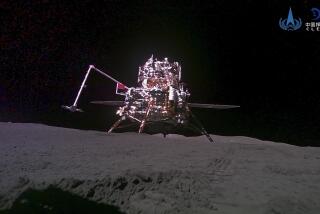NASA Probe Cassini Flies by Mysterious Saturn Moon
- Share via
NASA’s Cassini space probe confirmed Saturday that it had completed a flyby of Saturn’s moon Phoebe, coming within 1,285 miles of the small, dark body.
The craft’s main antenna was pointing away from Earth during the flyby Friday afternoon. Engineers at NASA’s Jet Propulsion Laboratory in Pasadena received word of the craft’s successful pass at 7:52 a.m. Saturday, when Cassini reoriented itself and began transmitting pictures and data to mission control.
Most of the data and pictures will be released Monday, but the early unprocessed images show that Phoebe is a badly pitted rock covered with craters and large gashes.
“This is an extremely battered, old surface we’re looking at,” said team member Torrence Johnson. “There are deep craters from other debris that over eons have pockmarked the surface. It’s roughly round, but it’s really chipped away.”
Saturday’s images reveal that the small moon, only 127 miles in diameter, is heavily cratered, with multiple impacts giving many of the craters a jagged, irregular appearance. Many of the craters are smaller than half a mile in diameter, indicating they were produced by the impact of bodies smaller than 100 yards in diameter.
Some of the craters have lighter rays extending outward, suggesting that the moon has a light-colored interior covered with a coat of darker material.
Whether the craters were caused by comets, asteroids or debris from other impacts within the Saturn system is hotly debated.
In fact, Phoebe’s origin is itself widely debated because it is an anomaly in the Saturn system. It is orbiting the planet in the direction opposite to all of Saturn’s other moons and is much farther out than any of the other large moons, about four times as far from Saturn as its nearest large neighbor, Iapetus.
Many planetary scientists think that Phoebe originated in the outer reaches of the solar system and was captured by Saturn rather than being formed along with Saturn and its other satellites.
Cassini made a variety of spectroscopic measurements of the moon that should reveal much about its composition and its origin. That information, along with pictures that are expected to have 10 times the resolution of Saturday’s, will be released Monday.
Friday’s flyby was Cassini’s only encounter with Phoebe. On June 30, the craft will fire its retrorockets and enter orbit around Saturn, where it will spend four years collecting data on the planet and its inner moons. The craft will also release the Huygens probe, which will descend to the surface of Titan, Saturn’s largest moon.





